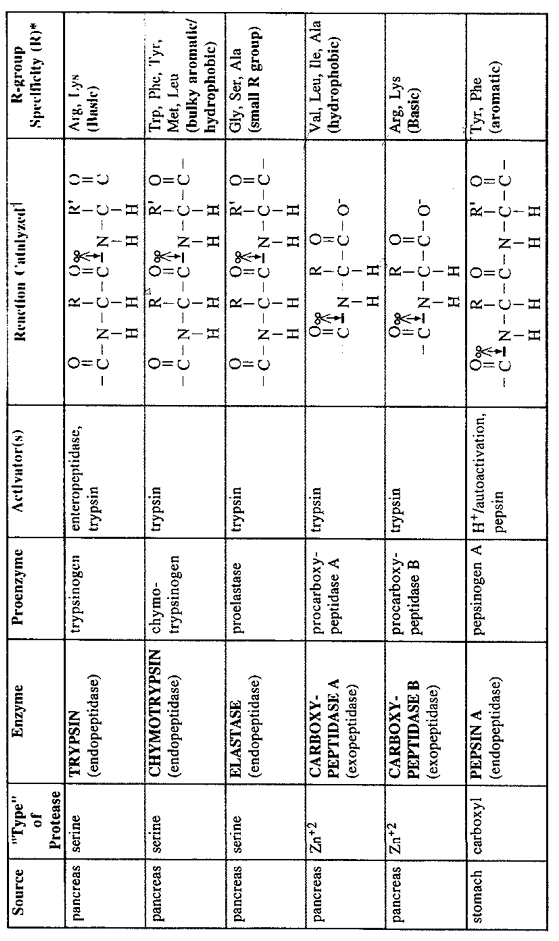
Digestion & Absorption of Proteins & Carbohydrates
Digestion and Absorption of Proteins
General Information:
1. Humans must ingest proteins, carbohydrates and lipids to maintain tissue and organ functions.
2. Most of these nutrients consist of large polymers that must be broken down before they can be made available to the intestinal cells for transport.
3. Dietary proteins are cleaved by hydrolases with specificity for the peptide bond (peptidases).
4. Endopeptidases (aka Proteases): attack internal protein bonds liberating large peptide fragments.
Exopeptidases: cleave off one amino acid at a time from the....
NH3+, aminopeptidases or COO- terminus, carboxypeptidase.
5. Endo- and Exopeptidases work in concert
The Big Picture:
Protein Digestion and Absorption

Gastric (Stomach) Digestion:
1. Gastric HCl is responsible for the low pH <2 of gastric juice.
2. Gastric acid kills microorganisms and denatures dietary proteins preparing them for hydrolysis by proteases.
3. Gastric juices contain the acid stable proteases of the pepsin family, which produce large peptide fragments and some free amino acids.
4. Protein digestion at this stage is partial, as the amino acids enter the duodenum, they trigger the release of cholectystokinin-pancreozymin (CCK-PZ) into the bloodstream.
This release initiates the secretion of protease zymogens from the pancreas and releases of enteropeptidase in the gut.
Pancreatic Proteases:
1. The pancreatic juice is rich in the proenzymes of endopeptidase and carboxypeptidases.
2. Enteropeptidase activates pancreatic trypsinogen to trypsin.
3. Trypsin autocatalytically activates more trypsinogen and other proenzymes, liberating chymotrypsin, elastase and the carboxypeptidases A and B.
Secretion and Activation of Pancreatic Proteases:

Digestion at the Brush Border (surface of intestinal epithelial cells):
1. Since pancreatic juice does not contain appreciable aminopeptidase activity, final digestion of di- and small peptides depends on brush border enzymes.
2. The surface of intestinal epithelial cells is rich in endopeptidases and aminopeptidases.
3. The end products of cell surface digestion are free amino acids and di- and tripeptides.
Absorption:
1. Following digestion, amino acids and small peptides are co-absorbed w/ sodium via group specific amino acid or peptide transport systems.
2. These processes are carrier mediated, discriminating between natural, L amino acids and D-amino acids, require energy (from the Na+ gradient, Na-K ATPase) and physiologic temperatures.
At least five brush border transport systems exist:
1. neutral amino acids (uncharged aliphatic and aromatic)
2. basic amino acids (Lys, Arg, Cys, Cys-Cys)
3. acidic amino acids (Asp, Glu)
4. imino acids (Pro), Hydroxyproline)
5. di- and tripeptides
Clinical Correlates:
1. Hartnup Disease:
Genetic defect in the neutral amino acid transporter.
Symptoms: dermatitis due to tryptophan malabsorption ("niacin" flush)
Consequences: not serious di- and tripeptide absorption supply minimal amounts of dietarily essential neutral amino acids.
2. Cystinuria:
Precursor to kidney stones
Symptoms: painful kidney stone formation due to malabsoprtion of cystine (two disulfide linked cysteines)
3. Sprue:
Destruction and flattening of the intestinal villi resulting in generalized malabsorption.
Causes: bacterial infection or gluten (contained in certain grains such as wheat and barley) sensitivity.
Digestion and Absorption of Carbohydrates
General Information:
1. Carbohydrates provide a major component of the daily caloric requirement, ~40%.
2.Distinguish between mono-, di- and polysaccharides.
Monosaccharides- do not need hydrolysis prior to absorption.
Disaccharides- require brush border enzymes.
Polysaccharides- require brush border enzymes, as well as, pancreatic amylase and salivary amylase for digestion.
Starch:
Hydrolyzed by a-amylase into Maltotriose, a-Limit Dextrin, Maltose, Glucose
a-1,4-glucosidic linkages (non-branching, amylose) and branched chains a-1,6 linkages (branch points, amylopectin)
a-amylase:
Present in saliva and pancreatic juice.
Specific for internal a-1,4-glucosidic bonds.
Brush Border Carbohydrate Digestion:
Final hydrolysis of di- and oligosaccharides to monosaccharides is carried out by a-glucosidases on the surface of the small intestine.

Monosaccharides are absorbed by carrier mediated transport.
At least two types are known:
1. Na+monosaccharide transporter
2. Na+ independent, diffusion type monosaccharide transport system

Undigested Carbohydrates:
1. Di-, oligo- and polysaccharides that are not hydrolyzed by a-amylase and/or brush border enzymes cannot be absorbed.
2. These carbohydrates reach the lower tract of the intestine which contains bacteria.
3. The bacteria utilize many of the remaining carbohydrate, metabolizing them and producing by- products such as: hydrogen gas, methane and carbon dioxide.

© Dr. Noel Sturm 2006